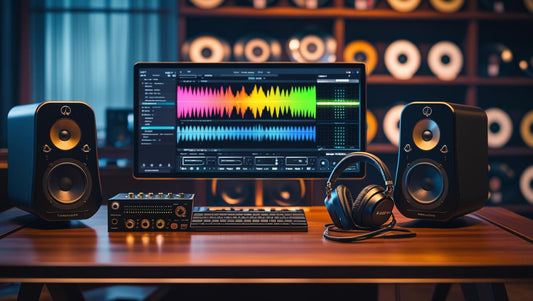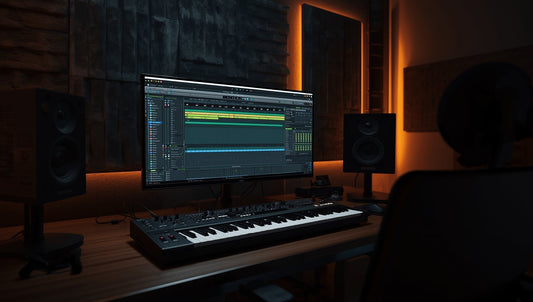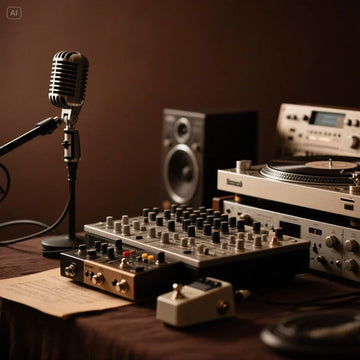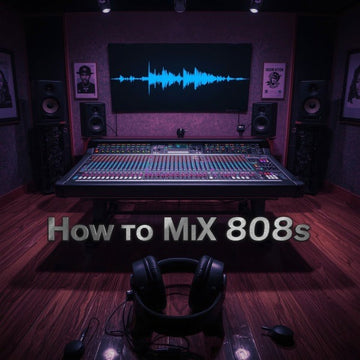How to Make Lo-Fi Beats That Actually Sound Good

Lo-fi beats are more than just background music. They capture mood, nostalgia, and emotion in a raw and simple way. But while they may sound effortless, making lo-fi beats that actually feel good takes more than dragging in a vinyl crackle and slowing down a sample. It’s about creating texture, imperfection, and warmth that connects with the listener.
In this guide, you’ll learn how to make lo-fi beats from scratch, including the tools, techniques, and small details that give your music that signature dusty glow. Whether you're new to production or looking to refine your sound, this step-by-step breakdown will help you craft lo-fi beats that feel real and sound timeless.
What Makes a Lo-Fi Beat?
Lo-fi, short for low fidelity, is a music style that embraces imperfection. It’s not just about mellow sounds—it’s about evoking a feeling. A good lo-fi beat often sounds like it came from a dusty record, full of warmth, noise, and human flaws. Instead of polishing every sound, producers leave in the grit. The goal is to create a calming, nostalgic atmosphere that feels raw and honest. Lo-fi beats are commonly used for studying, relaxing, or reflecting—and when done right, they become a vibe of their own.
Key characteristics (imperfections, textures, vibe)
Lo-fi beats typically include vinyl crackle, background noise, and detuned instruments. Imperfections like off-grid drum timing or pitch drift give the music a human feel. The texture is usually soft, warm, and slightly muffled, creating a cozy atmosphere. Reverb and ambient layers help add space and depth. All of these elements work together to create a vibe that is laid-back, emotionally rich, and soothing to the ear.
Lo-fi vs. other genres
Unlike polished genres like EDM or pop, lo-fi thrives on flaws. While trap and boom bap might focus on hard-hitting drums and sharp clarity, lo-fi pulls back. Its drums are often softer, the melodies are more relaxed, and the production feels intimate. Lo-fi also blends elements from jazz, soul, and old samples, giving it a timeless feel. It’s less about hype and more about mood.
Tools You Need to Start Producing Lo-Fi
Creating lo-fi music doesn’t require expensive gear or a big studio. You can start with a laptop, a DAW, headphones, and a few quality plugins or sample packs. The magic of lo-fi lies in how you use your tools to shape warmth, texture, and character. With the right digital setup, you can easily emulate the sound of vintage recordings. Simplicity is key—focus on vibe and emotion over technical perfection.
Best DAWs for lo-fi
FL Studio, Ableton Live, and Logic Pro are among the most popular DAWs for lo-fi production. They offer flexible workflows, great audio manipulation tools, and easy plugin integration. FL Studio is ideal for quick beat-making, while Ableton is great for ambient layering and effects. You don’t need the most expensive software—just one you’re comfortable with and that allows you to stay creative without limits.
Must-have plugins (free and paid)
For lo-fi, plugins that add warmth, saturation, and imperfections are essential. RC-20 Retro Color, iZotope Vinyl, SketchCassette, and Super VHS are top choices. For free options, try TAL-Reverb, Softube Saturation Knob, or Izotope Vinyl. These tools can degrade audio tastefully, emulate tape noise, and soften frequencies to mimic an old-school sound. A good EQ, some reverb, and a mild compressor also go a long way.
Sample packs and sound sources
Great lo-fi tracks often start with the right samples. Look for packs that include jazz chords, vinyl one-shots, ambient textures, dusty drums, and melodic loops. Sites like Splice, Loops de la Creme, and 12 Bit Soul offer high-quality collections. You can also sample old records, YouTube audio, or field recordings for a unique sound. The key is to choose sounds that already carry mood and vibe.

Step-by-Step Guide to Making a Lo-Fi Beat
Lo-fi production is all about layering simple, emotional elements in a way that feels cohesive and raw. You don’t need to overcomplicate the process. Start with a soft tempo, build drums that feel natural, add mellow melodies, sprinkle in some textures, and glue everything together with a laid-back bassline. The magic is in how these parts interact. Each sound should feel intentional and contribute to the overall mood.
Choosing your BPM and key
Lo-fi beats usually fall between 60 and 90 BPM, giving them a slow, relaxed groove. Choose a key that feels warm or nostalgic—common keys are A minor, D minor, or G major. These keys tend to work well for mellow progressions and soulful vibes. Don’t worry about being technically perfect. Go with what feels right emotionally.
Building dusty drums
Start with a simple kick-snare pattern and loose hi-hats. Use drum sounds that are slightly detuned or low-passed to remove harsh highs. Try layering soft claps, rimshots, or vinyl one-shots for added character. Humanize the timing by nudging notes slightly off-grid. This gives your drums an imperfect, organic feel that matches the lo-fi aesthetic.
Crafting mellow melodies
Use soft electric pianos, Rhodes, jazz guitar, or synth pads to create chill melodies. Focus on repetition and simplicity. Lo-fi melodies are often loop-based with subtle variation. Add slight pitch wobble, reverb, or chorus to soften the tone and bring out emotion. You want something that blends into the background but still carries feeling.
Adding textures: vinyl crackle, noise, ambiance
These subtle elements are key to creating depth and mood. Add a vinyl crackle loop, background hiss, or ambient room noise. These textures fill the empty space and make the beat feel lived-in. Keep them low in the mix so they support the music without overwhelming it. This is what gives lo-fi that dusty, vintage feel.
Basslines that sit in the pocket
Use soft sub bass or upright-style bass sounds with a mellow attack. Follow the chord root notes, and keep the rhythm laid-back. Let the bass support the groove rather than dominate it. Use EQ to roll off highs and let it sit under your drums and melody, gluing everything together without clashing.
Mixing and Mastering with a Lo-Fi Aesthetic
Mixing lo-fi is not about being clean and precise. It’s about embracing imperfection while making sure everything feels balanced and warm. Instead of trying to make the mix sound modern or bright, focus on softening harsh edges, blending layers, and preserving the mood. Mastering lo-fi beats should feel like sealing a memory in time—not pushing for loudness or sparkle.
Saturation, EQ, and reverb tricks
Use light saturation to add harmonic warmth to drums, melodies, or bass. A gentle tape-style saturator works best. Apply EQ to remove unnecessary highs or sub-bass to keep the mix soft. Reverb should be subtle and wide, not boomy. Try plate or room reverb with short decay to create space without overwhelming the elements.
How to downgrade for warmth
Lo-fi isn’t clean by design. Reduce sample rate slightly or use bit-crushing effects to bring a grainy tone. Add tape hiss, use filters to remove top-end sparkle, or apply wow and flutter plugins to mimic tape drift. This “downgrading” helps achieve the nostalgic, worn sound that defines lo-fi production.
Final polish without losing the feel
Before exporting, listen to how the elements sit together. Avoid over-compression or heavy limiting. Instead, use a gentle glue compressor to bind the mix, then apply a soft mastering chain with tape saturation and EQ. Keep the dynamics natural so the beat breathes. The goal is warmth and cohesion—not loudness or clinical precision.
Advanced Tips to Elevate Your Lo-Fi Beats
Once you’ve got the basics down, small creative decisions can take your lo-fi production to the next level. It’s not about adding complexity, but about adding soul and uniqueness. Advanced techniques like subtle timing shifts, smart sample use, and loop structure can make your beats stand out while keeping the chill aesthetic intact. These are the finishing touches that separate good lo-fi from great lo-fi.
Humanizing your patterns
Perfect timing can make music feel robotic. To give your beats a more natural groove, shift drum hits slightly off the grid and vary their velocity. Add a bit of swing to your hi-hats or ghost notes on the snare. For melodies, try slight pitch variations or modulating effects that mimic tape warble. These imperfections make your beat feel alive.
Sample chopping techniques
Instead of dragging full loops into your project, chop them into smaller pieces. Rearranging samples gives your beat a fresh, personalized feel. You can slice jazz riffs, vocal phrases, or ambient sounds, then re-layer them over your drums. Use filters, reverse, or pitch-shift techniques to give your chops a new character while still retaining the vibe.
Creating loops for streaming or lo-fi channels
Lo-fi beats made for streaming platforms often run as seamless loops. Structure your track with smooth transitions, gentle dropouts, and subtle variations every 8 or 16 bars. This keeps the listener engaged without breaking the calm mood. Avoid sudden stops or loud changes—your goal is to maintain a consistent, relaxed atmosphere perfect for playlists.
Final Thoughts
Lo-fi isn’t about perfection. It’s about emotion, texture, and creating a sound that feels like you. While techniques and tools are important, what matters most is the mood you capture. The more you produce, the more you’ll discover what sounds and imperfections reflect your style. Don’t chase trends—chase feeling. Let your instincts guide you. Over time, your lo-fi beats will start carrying a voice of their own. That’s when your sound becomes truly memorable.
1. Do I need expensive gear to make lo-fi beats?
No. You can start with just a laptop, a DAW like FL Studio or Ableton, a pair of headphones, and a few free plugins or sample packs. Lo-fi is all about vibe and emotion, not gear.
2. What tempo should I use for lo-fi beats?
Most lo-fi beats fall between 60 and 90 BPM. Slower tempos help create that relaxed, laid-back groove that lo-fi is known for.
3. What plugins are best for a lo-fi sound?
Popular choices include RC-20 Retro Color, iZotope Vinyl, SketchCassette, and Super VHS. Free options like TAL Reverb and Softube Saturation Knob also work well.
4. How do I add imperfections to make it sound lo-fi?
Use pitch wobble, vinyl crackle, off-grid timing, detuned chords, and tape-style saturation. These add human feel and analog texture to your beats.
5. How long should a lo-fi beat be?
Most lo-fi tracks are 1 to 2 minutes if made for beat tapes or streaming loops, but full compositions can run 2 to 3 minutes depending on your creative goal.
No comments








0 comments